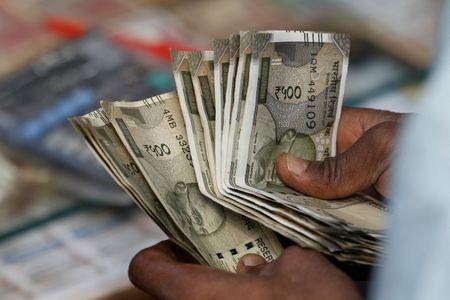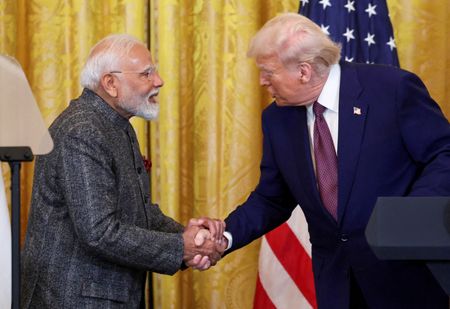By Ashwin Manikandan
MUMBAI (Reuters) – The Indian rupee suffered its worst monthly drop in nearly three years on Thursday, weighed down by U.S. tariff concerns and persistent portfolio outflows, with traders and analysts seeing little relief for the currency in the near term.
The rupee fell to an over five month low of 87.74 following U.S. President Donald Trump’s threat of a 25% charge on Indian exports, alongside an unspecified penalty, starting August 1. It closed at 87.5950 down 0.2% on the day.
The currency was down 2% for the month, its worst fall since September 2022.
The Reserve Bank of India likely intervened to support the rupee on Wednesday and Thursday, traders said, but noted that the intervention was not too aggressive.
The rupee could risk a fall below its all-time low of 87.95 if there are no positive developments around U.S.-India trade negotiations, traders said.
Foreign outflows added to the pressure, with overseas investors net selling Indian stocks worth $2 billon in July.
Economists at QuantEco said they expect the rupee to weaken towards 89.50 levels by March on a recovery in dollar sentiment and elevated global geo-economic and geopolitical uncertainties.
India’s equity benchmarks, the Nifty 50 and BSESN, fell as much as 0.9% in early trading, but pared losses to close about 0.3% lower.
Meanwhile, Asian currencies fell on Thursday, bogged down by weak Chinese economic data and the approaching August 1 U.S. tariff deadline. The dollar index was flat at 99.8 after rising nearly 1% in the previous session.
Later in the day, the focus will turn to U.S. personal consumption expenditure (PCE) inflation data to gauge the path of benchmark policy rates in the world’s largest economy.
(Reporting by Ashwin Manikandan; Editing by Sonia Cheema)









